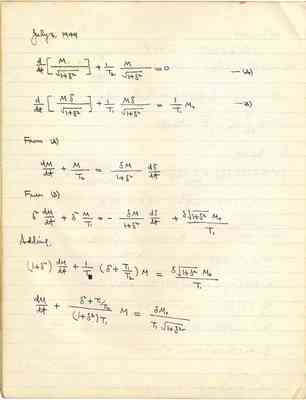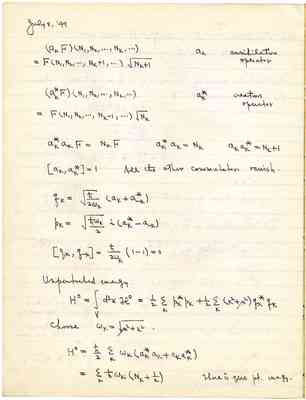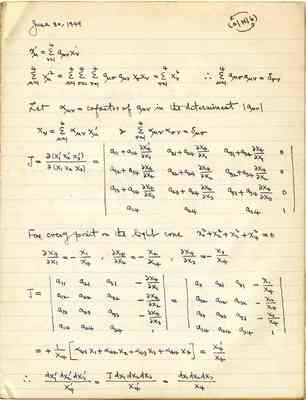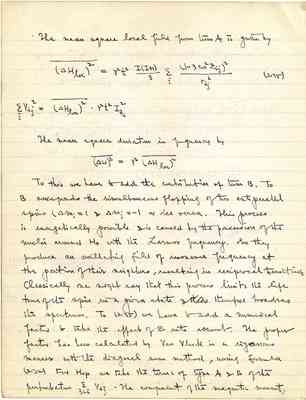Pages That Need Review
Research Notes II, 1949
117
For Lamb shift
Take the space integral we get
Take the expectation value
For 2S of H1 : 1050 μc/sec expt'l value : 1060 [μc/sec]
Bethe, P.R. 72, 339 ('47) Feynman P.R. 74, 1430 ('48) Lamb, Kroll P.R. 75, 388 ('49) Weisskopf, French, P.R. 75, 1240 ('49) Luttinger, P.R. 74, 893 (48) Welton, P.R. 74, 1157 (48) Dyson, P.R. 75, 486 [Dyson, P.R. 75,] 1736 (49)
41
| July 8, '49 | ||
|---|---|---|
| (aK F) (N1, N2, ..., NK, ...) = F (N1, N2, ..., NK + 1, ...) (square root of (NK + 1)) | aK | annihilation operator |
| (aK* F) (N1, N2, ..., NK, ...) = F (N1, N2, ..., NK - 1, ...) (square root of (NK)) | aK* | creation operator |
| aK* F = NK F | aK*aK = NK | aKaK* = NK + 1 |
| [aK, aK*] = 1 | See the other commutators vanish. | |
| qK = (square root of ([h?]/(2wK))) (aK + a-K*) | ||
| pK = (square root of (([h?]wK)/2)) [.~?] (aK* - a-K) | ||
| [qK, q-K] = ([h?]/(2wK)) (1 - 1) = 0 | ||
| Unperturbed energy | ||
| H[°?] = ∫V d3 x H[°?] = (1/2)([∑?]KpK*pK) + (1/2)([∑?]K(K2 + [M or U or N?]2))qK*qK | ||
| Choose wK = (square root of ([M or U or N?]2 + K2)) . | ||
| H[°?] = ([h?]/2) ([∑?]K) wK (aK*aK + aKaK*) = (([∑?]K)) ([h?]wK) (NK + (1/2)) | There is zero pt. magy. |
24
The mean square local field from term A is [?] by
The mean square deviation in frequency by
To this we have to add the contribution of term B. To B corresponds the simultaneous flopping of two antiparallel spins ( or vice versa. This process is energetically possible & is caused by the proession of the nuclei around H0 with the Larmor frequency. So they produce an oscillating field of resonance frequency at the position of their neighbors, resulting in reciprocal transitions. Classically we might say that this process limits the life time of the spin in a given state & thair therefore [?] the spectrum. To (2.35) we have to add a numerical factor to take the effect of B into account. The proper factor has been calculated by Van Vleck in a rigorous manner with the diagonal sum method, using formula (2.32) For Hop we take the terms of type A & B of the perturbation The component of the magnetic moment,











